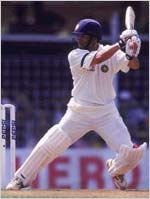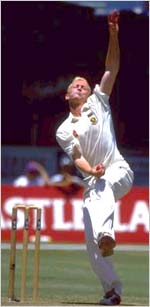Quality and leadership
Daniel Laidlaw
Having seen something of immense quality or significance, the natural instinct is to immediately attempt to place it in proper historical context. Lamentably, I have not seen many of Tendulkar's centuries, but his effort against South Africa must surely rank among his finest.
Midway through the pivotal first session of a pivotal first day of an important series, India had suffered a string of predictable, if somewhat unfortunate, dismissals. Unable to generate or sustain top-order partnerships on an excellent batting wicket, India were in grave danger of succumbing rapidly and crucially conceding all initiative to South Africa within half a day of the series. Once allowed control, one fancied South Africa would not relinquish it.
The dismissal of Ganguly, though, seemed to spark Tendulkar into action.
 With India listing at 68/4, his top order team-mates having failed him, Tendulkar took matters into his own hands, Sehwag under his experienced wing, and immediately began reversing the momentum and the course of the opening day.
With India listing at 68/4, his top order team-mates having failed him, Tendulkar took matters into his own hands, Sehwag under his experienced wing, and immediately began reversing the momentum and the course of the opening day.
When was the last time South Africa were belted for five runs per over for half a day on the first day of a Test? It cannot have been seen often in the modern era, if at all, and it revealed two main points of interest: The unquestioned quality of Tendulkar regardless of opposition and circumstances and the one-dimensional nature of South Africa's bowling and strategy.
From the time Tendulkar attacked Ntini and Kallis after his captain's demise, his shot selection was flawless and his execution impeccable. South Africa never gave their possible plan of starving him of runs an opportunity to work and Tendulkar was quickly in ascendancy.
Without support, though, it would have been a short-term solution. In that respect Tendulkar impressed not only with the quality of his innings but with his leadership, serving as a guiding influence to Sehwag and seemingly encouraging him to play within himself. The Indian dressing room sat and clapped Tendulkar's fifty but they were on their feet for Sehwag's. In leaderships stakes it was also notable how genuinely thrilled Ganguly was at Sehwag reaching his hundred, leaping to his feet to celebrate.
Even when Tendulkar was dismissed it must have felt to the South Africans as though they had only halved his influence for Sehwag continued the punishment. Occasionally it was difficult to tell which one was batting and there can be few higher compliments than that. One Sehwag straight drive off Ntini bested Tendulkar's offerings for shot of the day.
Outwardly nerveless, the most impressive aspects of Sehwag's innings were his immense maturity and the way he paced himself. The Dravidesque temperament made him appear anything but a debutant.
Paradoxically, the method of South Africa's early success was
also their
undoing, as not for the first time they demonstrated an
inability to adapt
their strategy to the circumstances of the game. Laxman and
Ganguly were
both dismissed by bouncers and Das also to a shorter ball,
which evidently
led the Proteas to believe that was best and only way to bowl
to India. The
blame for this has to rest on the shoulders of Pollock, who
should have
taken more heed of the way he dismissed Dravid. His team's
inflexible
approach proved costly.
 Short balls have to be accurate to be effective, which when
Hayward got the
suspect Ganguly, it was. But continued and misdirected
short-pitched bowling
can only play the batsmen in, which it did. The bounce evident
in the pitch
could have been far better utilised had the bowling been on a
consistently
good length, like when Pollock got Dravid, but the South
Africans remarkably failed to realise it. Hayward and Ntini scarcely deserved their
wickets, particularly true of Ntini's solitary scalp, and Pollock and
Kallis mostly
lacked an incisive edge, but that is mainly a reflection of how
well
Tendulkar and Sehwag played.
Short balls have to be accurate to be effective, which when
Hayward got the
suspect Ganguly, it was. But continued and misdirected
short-pitched bowling
can only play the batsmen in, which it did. The bounce evident
in the pitch
could have been far better utilised had the bowling been on a
consistently
good length, like when Pollock got Dravid, but the South
Africans remarkably failed to realise it. Hayward and Ntini scarcely deserved their
wickets, particularly true of Ntini's solitary scalp, and Pollock and
Kallis mostly
lacked an incisive edge, but that is mainly a reflection of how
well
Tendulkar and Sehwag played.
Pollock's captaincy lacked imagination but he actually had few options, given Klusener and Boje seem more like cameo bowlers and the sameness of the rest of the attack.
Whatever the South Africans did or did not do should not distract anyone from the performances of Tendulkar and Sehwag. The entire partnership was on something of a knife-edge, given the suspicion that five out meant all out.
Sehwag proved how easy Tendulkar made it look, as in the early part of his innings he attempted some of the same shots but simply missed.
Sehwag's contribution of 21 to the 100 partnership in 67 minutes said it all, but his level-headed support throughout was invaluable.
Even when Tendulkar finally holed out to deep mid wicket South Africa cannot claim to have found a way to get him out, as it was more mental error than forced mistake.
The expressions on the faces of the South Africans became increasingly bemused as the day wore on and they realised India were not going to hand them wickets just because they had a plan in mind and were sticking to it.
If nothing else, the initial failure of that plan should make South Africa doubt themselves more than could possibly have been hoped.
More Columns
Mail Daniel Laidlaw